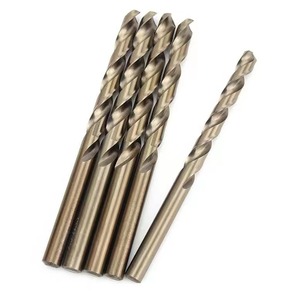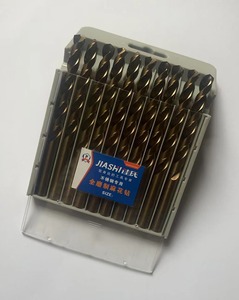
All categories
Featured selections
Trade Assurance
Buyer Central
Help Center
Get the app
Become a supplier

(3843 products available)














































Spade drill bits are specialized wide-bits designed to bore large holes into materials like wood, plastic and metal. This overall shape makes spade drill bits ideal for applications where deep holes are needed.
Spade bits feature sharp cutting edges, which help slice into tough substrates. Due to their robust construction, spade drill bits do not easily break from impact or collision, providing durability for drilling into hard materials.
The wide, flat profile of a metal spade drill bit enables it to remove large chips of waste from the hole being drilled. This efficient chip removal allows spade drill bits to work at faster speeds and with greater efficiency on tough materials.
The wide, flat shape of spade drill bits enables them to create large diameter holes quickly and efficiently in a variety of materials such as wood, plastic and metal. Here are the various types of spade drill bits:
Single-ended spade bits
Single-ended spade drill bits come with a smooth, flat end that is used for boring large and shallow holes in metal or hardwood. They are primarily used with drill presses or lathes and are available in widths ranging from inch to inch and in drilling depth from inch to inch. They are suited for general drilling in metalworking.
Double-ended spade bits
As the name implies, double-ended spade bits have cutting edges on both ends, thus allowing workers to flip the bit and continue drilling once one end becomes dull. This makes them ideal for extended operations where bit wear is an issue. However, this added complexity means it is less common than the single-ended variety.
Extended spade bits
These bits are designed with a longer shank, allowing workers to drill deeper holes into materials. Generally available in long lengths of up to 12 inches, extended spade drill bits are useful when drilling into very thick sheets of metal or other dense materials. However, longer drill bits may sacrifice some cutting power.
Notched spade bits
Notched spade bits include small notches or teeth at the end of the flat face. These assist with cutting larger swaths of material away at once. They can cut oversized holes faster than regular flat-ended spade drills. Notched bits are valuable where efficiency is key on challenging substrates.
Coated spade bits
Coated spade bits feature a thin layer of hard, low-friction material such as titanium or carbide bonded to the steel cutting edge. This prolongs bit life by reducing wear through heat and abrasion during extended drilling tasks. Coated spade drills excel on tough metals where standard bits quickly dull.
Spade drills, also known as bunnets or goblet drills, consist of a shaft that ends in a spoon-shaped working part. The wide, flat ends of spade drills make them good for drilling large diameter holes. They are sometimes confused with core drills, which also have a wide shape but only remove part of the material rather than the whole.
Spade drills come in different widths to create holes of various sizes. The narrowest tip is usually half an inch or less. The working part is made from strong tool steels like high-speed steel (HSS) or cobalt-coated steels. These materials remain hard and sharp, even when things get very hot.
Spade drills have diameters that range from 0.5 to 2 inches, which is wide enough to create large holes over an inch in diameter, although sizes can go up to 6 inches. Like other drills, the proper diameter is necessary for the application. Larger drills require less pressure but take more torque to rotate effectively.
The shank or shaft of spade drills comes in different sizes, normally in increments of ⅛ inch. Common sizes for power tools range from ¼ inch to ½ inch. Bigger sizes fit chunky drills and drill presses, while smaller widths suit handheld power tools.
To take care of spade drills, users should keep the working part lubricated with drilling oils or coolants. This oil helps whisk away the heat produced by friction during drilling, which could otherwise make the metal get too hot and become soft. If the metal gets soft, it will not cut sharp holes.
When not in use, the drills should be stored somewhere dry to prevent rust from forming on the working part. Covering or storing the drills in cases protects the sharp end from getting nicked or damaged. Periodically wiping the drill clean after each use and coating it with a thin layer of oil further prevents rust build-up. If there is any rust, gently brushing it off and reapplying oil protects the drill.
Users should also inspect spade drills before each use and check if the working part is still sharp. If there are any small nicks or dull spots, the working part can be sharpened back to a fine edge using sharpening tools designed for drills. Keeping the edge sharp ensures optimal cutting ability when boring holes into materials.
Due to their broad, flat-ended design, hole saw attachments are excellent for drilling sizable holes through wood, plastics, and some softer metals. Here are common cases:
Drilling wooden handles for tools
For making tool or hardware handles, spade drill bits create the needed wide holes to insert a securing metal tang. This effectively joins the handle to the main tool body through a friction fit or pinned rivet, enhancing stability in tough work conditions for users.
Drilling metal blanks for machining
Machinists often need to drill largish holes in metalwork blanks prior to turning or milling operations. Spade bits perform well at this stage, making initial clearance holes for cutting tools to then shape the blank into final parts or products. Their ability to handle mild steel makes them great for this task.
Creating vents in appliance cabinetry
Household appliances like clothes dryers have venting ducts inside and need spade drill bits to punch through the sheet metal cabinet. This creates air circulation paths for heating, cooling, or drying. Without vents, appliances would overheat, losing efficacy and safety, therefore becoming a fire hazard.
Drilling mounting holes in machining templates
Machine shops often use templates or fixtures/templates to boost production by repetitively locating where parts need machining. Spade bits help make necessary mounting holes in these guides, positioning them precisely aligned with drills, mills, or lathes workspace. This optimizes the placement and spacing of parts on machines.
Drilling through steel for construction
In construction and fabrication settings, spade bits wielded by cordless drills enable workers to drill mounting holes through structural steels. Such holes allow for insertion bolts, rivets, or other fasteners to connect pieces like beams and girders securely, forming the load-bearing framework structures.
Choosing the right spade drill bits involves considering several factors:
Material
Spade drill bits come coated with titanium, tungsten carbide and cobalt, hence one should select a spade drill bit whose material complements the work at hand. Spade drill bits with titanium coating should be used when drilling soft materials because titanium is non-stick. Spade drill bits with cobalt and tungsten carbide are extremely hard and should be used when drilling hard materials. Spade drill bits without coating are recommended when drilling non-ferrous metals since they tend to wear quickly.
Diameter
Spade drill bits are available in various diameters. The diameter of spade drill bits ranges from 14mm to 38mm, which are ideal for drilling bigger holes since they have a greater cutting edge. To achieve perfect results, the diameter of the spade drill bit has to be proportional to the horsepower of the machine used.
Chip removal capability
One should also consider spade drill bit's ability to remove debris and chips. For instance, when drilling softwood, a spade drill bit with a smooth head should be used because it is capable of easy chip removal. On the other hand, when drilling hardwood, a spade drill bit with a pronounced shaft twist, such as a fluted spade drill bit, should be used because it is capable of better chip removal.
Length
Consider the length of the spade drill bit, as it should be longer than the thickness of the material to be drilled. The reason why one shouldn't use a longer drill bit than required is because it may cause bending during drilling and give inexact results. Also, longer drill bits may inconvenience drilling in tight spaces.
A1: Cobalt is suitable for c2od work on hard metals. Tungsten carbide is known for its extreme hardness, hence it is ideal for all-purpose work on metals with varying degrees of hardness.
A2: Material, coating, and diameter are factors that determine the duration of a drill bit. Other factors that affect longevity include the hardness of the material to be drilled, drilling speed and pressure, lubrication, and cooling.
A3: Spade drill bits are suitable for creating large holes in mild steel when used with a drill press.
A4: Cobalt coating improves a drill bit's resistance to high temperatures.
A5: Use a shorter drill bit that is proportional to the thickness of the material, amount of drilling depth, and horsepower of the machine.